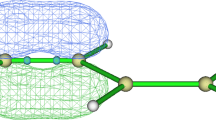Abstract
The stability of a spatial configuration and the coordinating ability of the transition-metal ions are discussed in the MO approach, using the notions of molecular orbital stabilization energy and the bond stabilization energy.
Similar content being viewed by others
References
Basolo, F. & Pearson, R. G. (1961)Mechanisms of Inorganic Reactions (John Wiley & Sons, Inc., New York, London).
Candlin, J. P., Taylor, K. A. & Thompson, D. T. (1968)Reactions of Transition-Metal Complexes (Elsevier Publishing Company, Amsterdam, London).
Lepădatu, C. I. (1970)Z. phys. Chem. (NF.) 73, 249.
Orgel, L. E. (1961)An Introduction in Transition-Metal Chemistry (Methuen & Co. Ltd., London).
Schäffer, C. E. & Jørgensen, C. K. (1965)Mol. Phys. 9, 401.
Schmidtke, H.-H. (1971)Theoret. Chim. Acta 20, 92.
Spacu, P. & Lepădatu, C. I. (1971)Z. phys. Chem. (NF.), to be published.
Author information
Authors and Affiliations
Rights and permissions
About this article
Cite this article
Lepădatu, C.I. Molecular orbital stabilization energies for coordination clusters. Journal of Crystal and Molecular Structure 1, 397–400 (1971). https://doi.org/10.1007/BF01201130
Received:
Issue Date:
DOI: https://doi.org/10.1007/BF01201130




